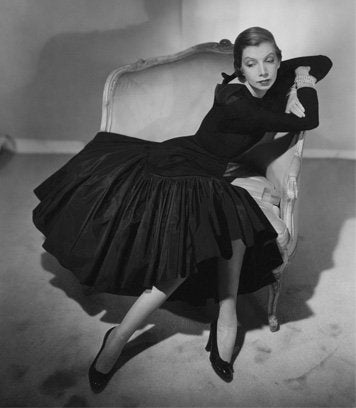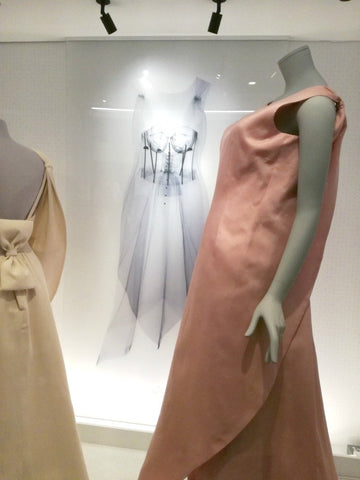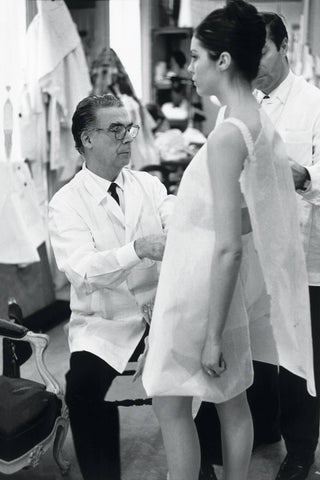Last week I went to the Balenciaga exhibition at the V&A Museum and I have to say that it’s been one of the most beautiful fashion/related exhibits I have seen in a while. Absolutely amazing getting to know the Spanish-born designer, his life, the tailoring, sewing and pattern drafting techniques he used and invented!
I was also amazed by the toiles/muslins and tools he and his team used to create amazing garments that were admired by names such as Coco Chanel or worn by celebrities and upper class members from all around the world like the Duchess of Windsor, Pauline de Rothschild or Gloria Guinness.

Gloria Guinness

Pauline de Rothschild
His work was directly linked to architecture and lots of his designs had a feeling of something “built” on a woman’s body. The exhibition itself is divided in two different parts. The first that you see as soon as you get in with all his work and life tangled up on a chronological order, and another one on the floor above with garments from designers influenced by Balenciaga, from Oscar de la Renta to Ungaro or Givenchy, among more modern creators.
Cristóbal Balencigaa was born in Getaria, a small fishing village in the North of Spain, where his passion for sewing started since he was a child thanks to his mum who worked as a seamstress. At 12 years old he started as a tailor apprentice and in his teenage years a famous upper class figure who saw his talent became her patron and sent him to Madrid to properly train in tailoring.
In 1919 he came back to the North, to the Basque city of San Sebastián, where he opened his first boutique under the name Eisa. He opened another one in Madrid and in Barcelona. When the Civil War started, Balenciaga moved to Paris where he lived for almost the rest of his life and where he opened another shop.
There he also had a studio with pattern cutters and seamstresses, although being a perfectionist, he used to oversee every single detail of the making of his designs. Known as “The King of Fashion”, the Spanish designer was able to drape, cut and fit his own patterns, unlike other designers. He had a vast knowledge of both technique and construction, and advanced tailoring skills.
Some of his most famous designs (The Balloon Jacket in 1953; The Tunic Dress in 1955; The Chemise Dress and Cocoon Coat in 1957; or the empire line dresses and coats cut like kimonos and with a high waist), that looked like actual sculptures made out of fabric, featured a completely new silhouette, different from the popular “New Look” created by Dior.

The Tunic Dress

Balloon jacket

Balloon jacket in green
Balenciaga changed the waist on his designs giving it more room, compared to the usual, very small one found on the garments designed at the time, apart from adding more fluid lines to his creations.
Another of his special touches could be seen on the way the collars stood, away from the collarbone, so that the necklace could be seen; something that also happened with the so called “bracelet-sleeve”, a 3/4 sleeve that let the wearer shown her beautiful (and expensive) jewellery.
Apparently, the Spaniard was “obsessed” with sleeves and could be heard shouting in his studio in Spanish: “¡La manga! ¡La manga!” (“The sleeve! The sleeve!”). For him it was the base of any design.

These sleeves look familiar! Super on trend these days 🙂

The Cape (I love this design!)
One of his most popular designs was also the one-seam/ square coat in which the sleeve is cut in one piece with the joke. At the exhibition you can actually play with this design and make yourself one (out of paper, like origami).
All of these were copied (and still do till this day) by cheaper and the first high-street boutiques at the time. Even during the WWII, his clients risked travelling to Europe just to have one of his designs made.
The one-seam coat

Another beautiful image of the coat
From the whole exhibition, apart from the amazing dresses, coats and more that you can see, I spent a huge amount of time checking out the toiles/muslins which were full of notes, marks and annotations regarding changes, fit and more.

One of the toiles at the exhibition

Also you can take a look at the rich and bold materials Balenciaga preferred, heavy cloths and ornate embroideries. The designer worked closely with the Swiss fabric house Abraham and you can see a book full of fabric swatches at the exhibition.
You can also learn about the construction of some of his designs thanks to an X-RAY that had been made to some of them. This was one of my favourite parts. Brilliant!


I want to end the post with this quote from one of his clients: “Women did not have to be perfect or even beautiful to wear his clothes. His clothes made them beautiful.”

Balenciaga at work photographed by Henri Cartier-Bresson
Hope you liked this post and sorry for the quality of some of the images but the lighting at the exhibition was not the best. Don’t miss the exhibition if you are in London. Totally worth it!
See you again soon and happy sewing!
Ana
xx
Credits: Info from Victoria and Albert Museum in London and The Met in New York. Images from Pinterest.
